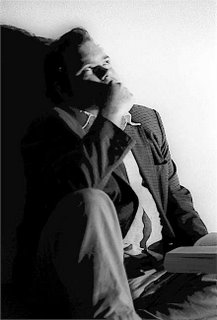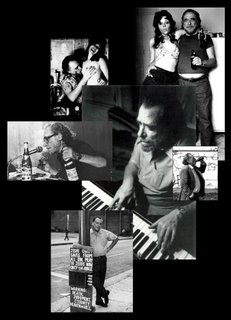Scum (1977, 1979)
 Scum
Scum (1977, 1979) has the distinction of only a few films in history to have been filmed twice by the same director, here Alan Clarke. Few other flicks given this jump instantly to min, however two notable entries, Hitchcock’s
The Man Who Knew Too Much (1934, 1956), and Rodriguez’
El Mariachi (1992), re-made as
Desperado (1995) spring to mind. Generally these remakes offer a better budget and a learning curve and stylistically at least, are the better gamble come popcorn time.
This is not the case with the Harvey Keitel movie The Corrupt Lieutenant (Faenza 1983), which Frank has just picked up for $2.00 in a flea market in Burlington, Vermont. Frank had assumed the film was the same as Keitel’s infamous The Bad Lieutenant (Ferrara 1992). Whereas he has thought he bought a Japanese bootleg with a mistranslated title, Frank, popping it into his portable DVD player in his hotel room, was surprised to find the mystery disc actually contained the movie better known as Copkiller, probably re-named to sucker in buyers like Frank thinking they were getting the Ferrara movie at a bargain price. But, Copkiller is an okay flick too, and notably has John Lyndon, a.k.a. Johnny Rotten as the title cop killer.
However, Scum 1977 and 1979 are essentially the same movie and are conveniently packaged together by Blue Underground, available February 28, 2006. The price isn’t bad either at $17.99 on Amazon.com.
 Scum
Scum ’77 was made by Clarke for the BBC. It is shot on dark, gritty film stock and is fairly low budget; it is a fast unwinding tale of bad boys going badder in a British borstal—reform school, under the watch of cruel guards and wardens. And it features a young Ray Winstone (
Sexy Beast, Glazer 2000). However, the BBC found it too graphically violent or perhaps truthful and squashed the film. Though the reform school is shown to be as full of racism, sexual assault and inmates brutally beating each other, as an adult prison, the real expose is of the corrupt, old fashioned system itself, as evident form the first scene to the last.

Knowing he was on to something, by 1979, Clarke had gotten up the production money and re-shot the thing for theatrical release. The result is a film not quite so dark and gritty; it’s shot on better film stock and at a slightly less claustrophobic borstal. The pace is slower too. What happens is, though the plot and 95% of the casting is identical, the film is much more open and better allows the audience to warm up to the characters and even follow the story. Simply put, a better-looking film is always much more palatable to the general audience, no matter what the subject matter is. Also, with out the TV language restrictions, the dialogue in Scum ’79 is much more realistic. After all, what is Ray Winstone without dropping a few F-bombs?
In fact the main noticeable plot difference in the theatrical release is the absence of one particular homo-erotic subplot in which Winstone, having clubbed his way to being the new “Daddy” of the borstal, propositions one of the more comely young boys. In the BBC version, this intrigue seems shoved in more or less just for shock value. In fact, Alan Parker did the same exact thing towards the end of Midnight Express (1978). It’s just a knee-jerk surprise that only distracts from the plot. Perhaps Clarke saw this in the interim and wisely cut it out?
Perhaps also, John Hurt’s character in Midnight Express, was of inspiration to?: The character of Archer, the self styled reform school Jesus, becomes a lot more serene and likeable between the two films and this is not just a reflection of this one major change in casting between the two films. Of course, once again, the overall “breathing room” in both time and space, allotted the audience in Scum ’79 is also big help in exploring Archer’s kindness amongst the rowdy, angry and desperate boys.

Anyway, luckily for Clarke, the magic happened with Scum even a second time around. That doesn’t happen much in life. “Certainly not in love,” Frank muses, “or in movies.”
“Or with vintage electronics” frank groans and kicks the used portable Teac reel-to-reel player that he had picked up at the flea market for $40. She looked like a real beaut, all right. But back in his room he found the two of three heads missing, the wiring frayed and the spindles stuck…

 this thing upon me is not death
but it's as real
and as landlords full of maggots
pound for rent
I eat walnuts in the sheath
of my privacy
and listen for more important
drummers;
it's as real, it's as real
as the broken-boned sparrow
cat-mouthed, uttering
more than mere
miserable argument;
between my toes I stare
at clouds, at seas of gaunt
sepulcher. . .
and scratch my back
and form a vowel
as all my lovely women
(wives and lovers)
break like engines
this thing upon me is not death
but it's as real
and as landlords full of maggots
pound for rent
I eat walnuts in the sheath
of my privacy
and listen for more important
drummers;
it's as real, it's as real
as the broken-boned sparrow
cat-mouthed, uttering
more than mere
miserable argument;
between my toes I stare
at clouds, at seas of gaunt
sepulcher. . .
and scratch my back
and form a vowel
as all my lovely women
(wives and lovers)
break like engines  into steam of sorrow
to be blown into eclipse;
bone is bone
but this thing upon me
as I tear the window shades
and walk caged rugs,
this thing upon me
like a flower and a feast,
believe me
is not death and is not
glory
and like Quixote's windmills
makes a foe
turned by the heavens
against one man;
...this thing upon me,
great god,
this thing upon me
crawling like
into steam of sorrow
to be blown into eclipse;
bone is bone
but this thing upon me
as I tear the window shades
and walk caged rugs,
this thing upon me
like a flower and a feast,
believe me
is not death and is not
glory
and like Quixote's windmills
makes a foe
turned by the heavens
against one man;
...this thing upon me,
great god,
this thing upon me
crawling like  snake,
terrifying my love of commonness,
some call Art
some call Poetry;
it's not death
but dying will solve its power
and as my grey hands
drop a last desperate pen
in some cheap room
they will find me there
and never know
my name
my meaning
nor the treasure
of my escape.
~ Buk
snake,
terrifying my love of commonness,
some call Art
some call Poetry;
it's not death
but dying will solve its power
and as my grey hands
drop a last desperate pen
in some cheap room
they will find me there
and never know
my name
my meaning
nor the treasure
of my escape.
~ Buk

 Scum ’77 was made by Clarke for the BBC. It is shot on dark, gritty film stock and is fairly low budget; it is a fast unwinding tale of bad boys going badder in a British borstal—reform school, under the watch of cruel guards and wardens. And it features a young Ray Winstone (Sexy Beast, Glazer 2000). However, the BBC found it too graphically violent or perhaps truthful and squashed the film. Though the reform school is shown to be as full of racism, sexual assault and inmates brutally beating each other, as an adult prison, the real expose is of the corrupt, old fashioned system itself, as evident form the first scene to the last.
Scum ’77 was made by Clarke for the BBC. It is shot on dark, gritty film stock and is fairly low budget; it is a fast unwinding tale of bad boys going badder in a British borstal—reform school, under the watch of cruel guards and wardens. And it features a young Ray Winstone (Sexy Beast, Glazer 2000). However, the BBC found it too graphically violent or perhaps truthful and squashed the film. Though the reform school is shown to be as full of racism, sexual assault and inmates brutally beating each other, as an adult prison, the real expose is of the corrupt, old fashioned system itself, as evident form the first scene to the last.




